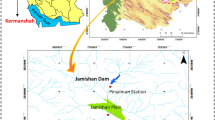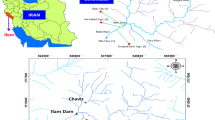Abstract
Rainfall distributions in Iran are spatially and temporally heterogeneous, a fact probably linked to the mostly arid and semi-arid climate of the country. On the other hand, water demand is increasing with increasing population and improving life style. At present, the optimal utilization of water resources and irrigation dams is the primary concern of water resource managers. The Eleviyan dam (with a capacity of 60 hm3) was constructed to meet the irrigation and municipal water needs of the Maraghan region (Northwestern Iran). In this study, the efficiency of the Eleviyan irrigation dam system was investigated in three phases by setting up the optimization model that maximized the water release for irrigation purposes after municipal water need were met. In the first phase, the inflows measured in the 21 years prior to the construction of the reservoir, and in the second, the inflows generated by the Monte Carlo simulation method, and in the third phase, the inflows after the construction of the reservoir were used. The results demonstrate that the capacity determined during the preliminary studies was accurate and the operation carried out in the recent periods of operation life was up to a satisfactory standard.













Similar content being viewed by others
References
Allen RG, Pereira LS, Raes D, Smith M (1998) Crop evapotranspiration––guidelines for computing crop water requirements, FAO Irrigation and drainage paper 56. Rome, Italy
Aksoy H, Bayazit M (2000) A daily intermittent stream flow simulator. Turkish J Eng Environ Sci 24:265–276
Anonymous (2007) Hydrological reports of Eleviyan reservoir dam. Ministry of Energy, East Azerbaijan Regional Watercorp
Belaineh G, Peralta RC, Hughes TC (1999) Simulation/optimization modeling for water resources management. J Water Resour Plan Manag 125(3):154–161
Consoli S, Matarazzo B, Pappalardo N (2008) Operating rules of an irrigation purposes reservoir using multi-objective optimization. Water Resour Manag 22:551–564
Duranyildiz I, Onoz B, Bayazit M (1999) A chance-constrained LP model for short term reservoir operation optimization. Turkish J Eng Environ Sci 23:181–186
El-Awar FA, Labadie JW, Ouarda TBMJ (1998) Stochastic differential dynamic programming for multi-reservoir system control. Stoch Environ Res Risk Assess 12:247–266
Faber BA, Stedinger JR (2001) Reservoir optimization using sampling SDP with ensemble streamflow prediction (ESP) forecast. J Hydrol 249:113–133
Hajilal MS, Rao NH, Sarma PBS (1998) Real time operation of reservoir based canal irrigation systems. Agric Water Manag 38:103–122
Jain SK, Singh VP (2003) Water resources systems planning and management. Elsevier, Developments in Water Science, No. 51
Jain SK, Goel MK, Agarwal PK (1998) Reservoir operation studies of Sabarmati system, India. J Water Resour Plan Manag 124(1):31–38
Jothiprakash V, Shanthi G (2006) Single reservoir operating policies using genetic algorithm. Water Resour Manag 20:917–929
Lettenmaier DP, Wood EF (1993) Handbook of hydrology. McGraw-Hill, New York
Loucks DP, Van Beek E (2005) Water resources systems planning and management, an introduction to methods, models and applications. Studies and reports in hydrology, Unesco Publishing, p 680
Maidment VR, Chow VT (1981) Stochastic state variable dynamic programming for reservoir systems analysis. Water Resour Res 17(6):1578–1584
Mathlouthi M, Lebdi F (2008) Event in the case of a single reservoir: the Ghezala dam in Northern Tunisia. Stoch Environ Res Risk Assess 22:513–528
Mays LW, Tung YK (1992) Hydrosystems engineering and management. Water Resources Publications, USA
Montaseri M, Adeloye AJ (1999) Critical period of reservoir systems for planning purposes. J Hydrol 224:115–136
Nandalal KDW, Sakthivadivel R (2002) Planning and management of a complex water resource system: case of Samanalawewa and Udawalawe reservoirs in the Walawe River, Sri Lanka. Agric Water Manag 57:207–221
Ngo LL, Madsen H, Rosbjerg D (2007) Simulation and optimisation modelling approach for operation of the Hoa Binh reservoir, Vietnam. J Hydrol 336:269–281
Ozturk F, Yurekli K, Apaydin H (2008) Stochastic modeling of suspended sediment from Yesilirmak Basin, Turkey. Int J Nat Eng Sci 2(1):21–27
Raju KS, Kumar DN (1999) Multicriterion decision making in irrigation planning. Agric Syst 62:117–129
Rao NH, Sarma PBS, Chander S (1992) Real-time adaptive irrigation scheduling under a limited water supply. Agric Water Manag 20:267–279
Rosenthal RE (2008) GAMS user’s guide. GAMS Development Corporation, USA
Sattari MT, Kodal S, Ozturk F (2006) Application of deterministic mathematical method in optimizing the small irrigation reservoir capacity. Akdeniz J Agric Sci 19(2):261–267
Sattari MT, Salmasi F, Ozturk F (2008) Comparison of different methods used in determination of irrigation reservoir capacity. J Agric Sci 14(1):1–7
Shrestha BP, Duckstein L, Stakhiv EZ (1996) Fuzzy rule-based modeling of reservoir operation. J Water Resour Plan Manag 122(4):262–269
Suiadee W, Tingsanchali T (2007) A combined simulation––genetic algorithm optimization model for optimal rule curves of a reservoir: a case study of the Nam on irrigation project. Thailand Hydrol Process 21:3211–3225
Tu M, Hsu N, Yeh WW (2003) Optimization of reservoir management and operation with Hedging rules. J Water Res Plan Manag 129(2):86–97
Wurbs RA (2005) Comparative evaluation of generalized river/reservoir systems models. Texas Water Resources Institute, pp 65–82
Yeh WW-G (1985) Reservoir operations and management models: a state-of-the-art review. Water Resour Res 21(12):1797–1818
Author information
Authors and Affiliations
Corresponding author
Rights and permissions
About this article
Cite this article
Sattari, M.T., Apaydin, H. & Ozturk, F. Operation analysis of Eleviyan irrigation reservoir dam by optimization and stochastic simulation. Stoch Environ Res Risk Assess 23, 1187–1201 (2009). https://doi.org/10.1007/s00477-008-0292-9
Published:
Issue Date:
DOI: https://doi.org/10.1007/s00477-008-0292-9




